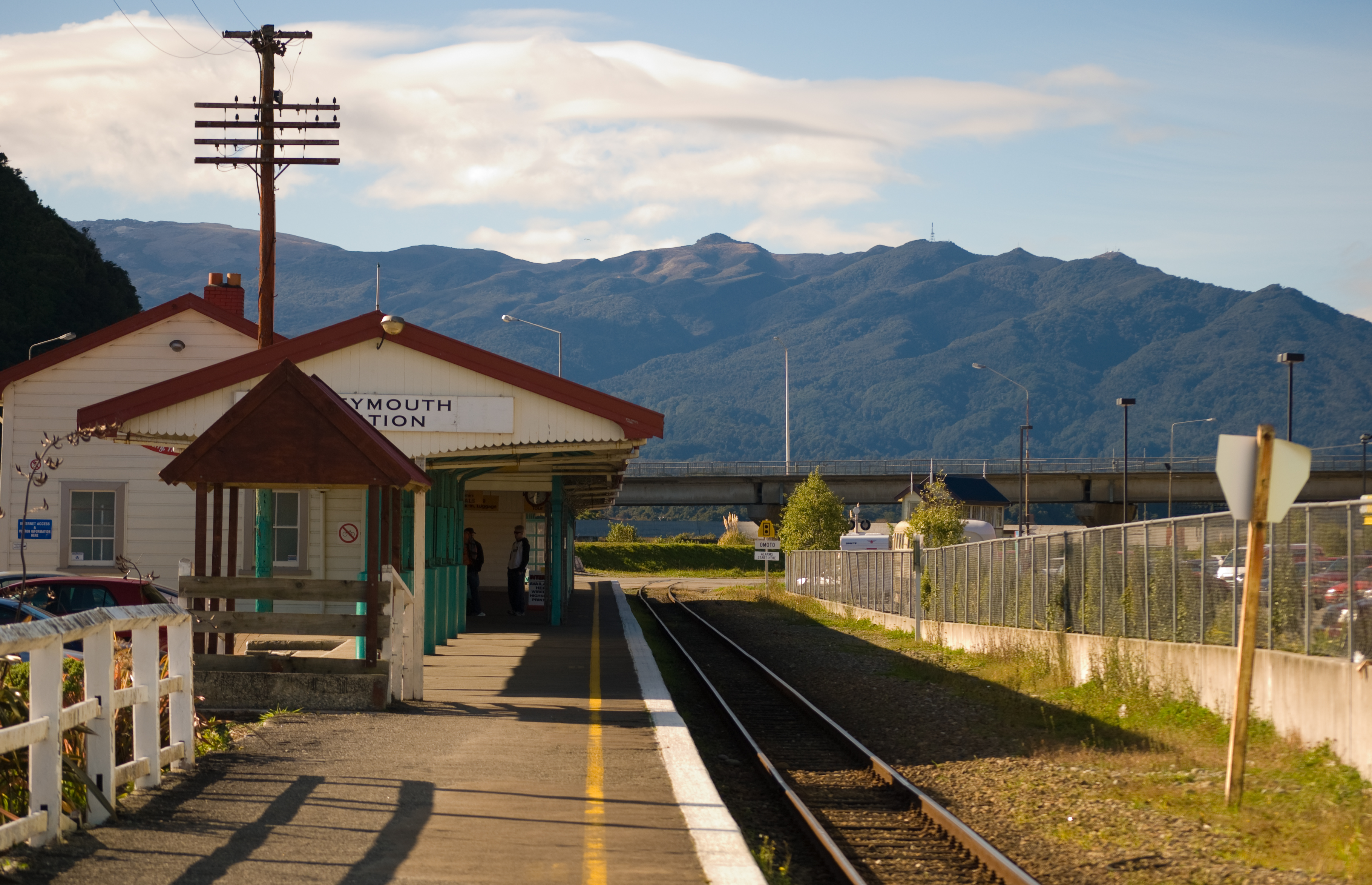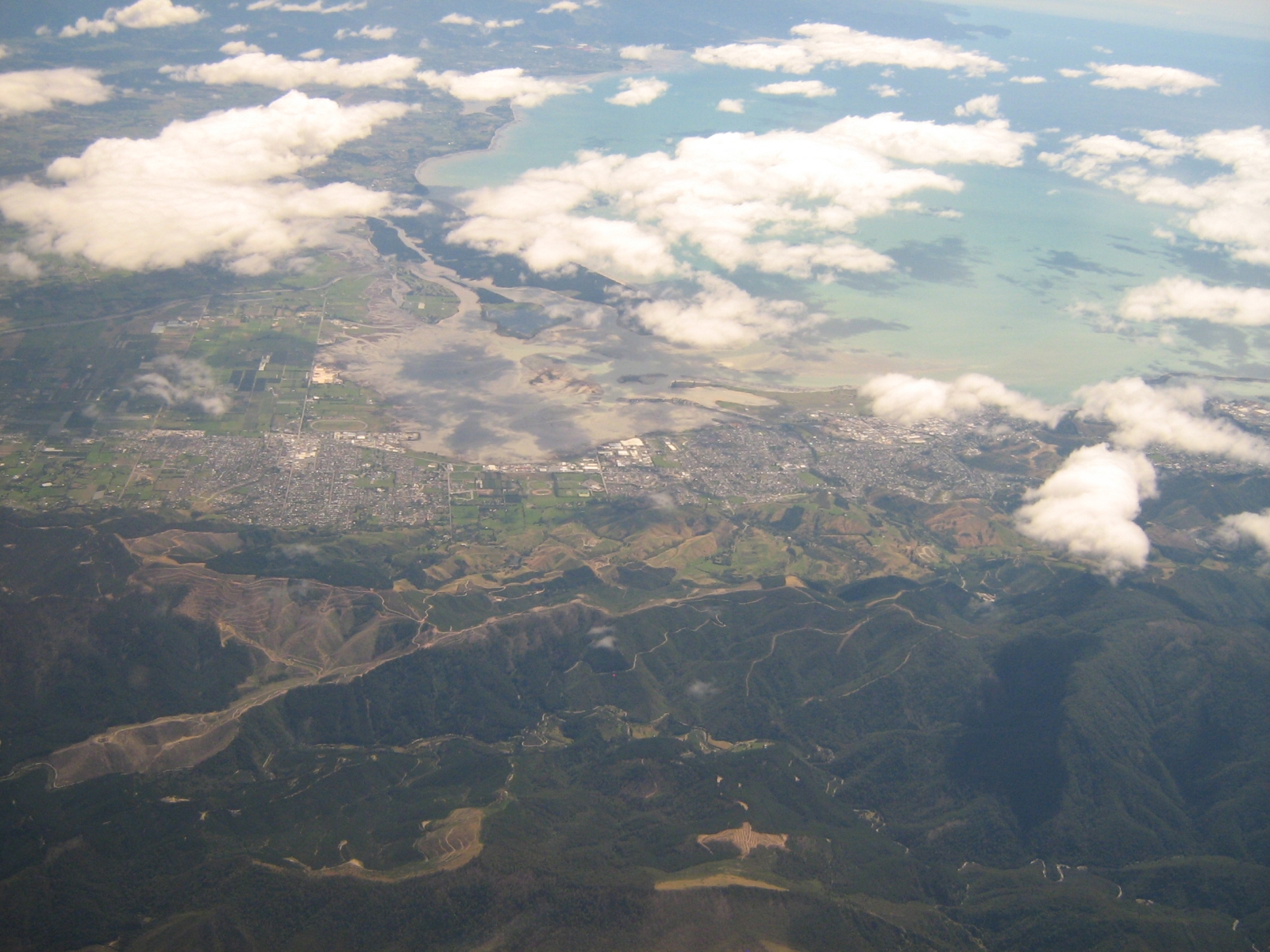|
Ross Branch (railway Line)
The Ross Branch, officially known as the Hokitika Line since 2011, and previously as the Hokitika Industrial Line, is a branch line railway that forms part of New Zealand's national rail network. It is located in the Westland District of the South Island's West Coast region and opened to Hokitika in 1893. A further extension to Ross operated from 1909 until 1980. Construction The first line opened in the region was a bush tramway built to a gauge of 1,219mm (4 ft). It ran from Greymouth south to Paroa and opened in 1867. Ten years later, an extension inland to Kumara was opened, with the Taramakau River crossed by a cage suspended from a wire. Around this time, plans were formulated to replace the tramway with a railway and link Greymouth and Hokitika. Work began in 1879, but the economic conditions of the Long Depression brought construction to a halt the next year with only 5 km of track laid. Furthermore, the residents of Kumara, led by future Prime Minister ... [...More Info...] [...Related Items...] OR: [Wikipedia] [Google] [Baidu] |
Prime Minister
A prime minister, premier or chief of cabinet is the head of the cabinet and the leader of the ministers in the executive branch of government, often in a parliamentary or semi-presidential system. Under those systems, a prime minister is not the head of state, but rather the head of government, serving under either a monarch in a democratic constitutional monarchy or under a president in a republican form of government. In parliamentary systems fashioned after the Westminster system, the prime minister is the presiding and actual head of government and head/owner of the executive power. In such systems, the head of state or their official representative (e.g., monarch, president, governor-general) usually holds a largely ceremonial position, although often with reserve powers. Under some presidential systems, such as South Korea and Peru, the prime minister is the leader or most senior member of the cabinet, not the head of government. In many systems, the prime minister ... [...More Info...] [...Related Items...] OR: [Wikipedia] [Google] [Baidu] |
Stuart And Chapman's Bush Tramway, Rimu
Stuart and Chapman's bush tramway, Rimu was a long bush tramway with a gauge of probably 2-foot 6-inch (762 mm) at Seddon's Terrace Sawmill in Rimu, New Zealand. It ran south of Ross to the Lake Ianthe area.Heather Newby''Logging gang on Stuart and Chapman's bush tramway, Rimu.'' Retrieved 9 August 2018. It was used from at least 1899 to 1962. History Seddon's Terrace Sawmill in Rimu was founded by David Patrick Stuart and John Chapman. They started sawmilling in 1899 after they had built their first sawmill at Seddon Terrace. The mill was located about from Hokitika. The plant comprised a 30 hp boiler, a 16 hp stationary steam engine of sixteen horse-power, Bullock's patent bench, and the usual paraphernalia. The output was 6000 superfeet per day. The timber was carted by road to Hokitika by a contract system. However, timber for local consumption was delivered by the firm's own teams. Fourteen persons were employed. [...More Info...] [...Related Items...] OR: [Wikipedia] [Google] [Baidu] |
Mikonui River
The Mikonui River is a river of the West Coast Region of New Zealand's South Island. It flows northwest from its sources in the Southern Alps, reaching the Tasman Sea close to the township of Ross. Early settlers on the Mikonui Charles Shearer (born 1826 in Denny, Scotland) and his wife Janet (born Costdyke, Scotland) settled in Mikonui in 1868. In 1881 Charles advertised his Mikonui River water-race for sale in the ''West Coast Times'' for two hundred pounds. See also *List of rivers of New Zealand This is a list of all waterways named as rivers in New Zealand. A * Aan River * Acheron River (Canterbury) * Acheron River (Marlborough) * Ada River * Adams River * Ahaura River * Ahuriri River * Ahuroa River * Akatarawa River * Ākitio R ... References Goa Way Back, Early Hari Hari - Vic Berry, Published 1986Paperspast External links Rivers of the West Coast, New Zealand Rivers of New Zealand Westland District {{WestCoastNZ-river-stub ... [...More Info...] [...Related Items...] OR: [Wikipedia] [Google] [Baidu] |
Waitaha River
The Waitaha River, also known as the Mount Cook of rivers, is a river of the West Coast region of New Zealand's South Island. One of the best whitewater rivers in New Zealand (if not the best), the hydroelectricity project has been rejected by the New Zealand government. Waitaha is Māori and it literally means ''wai'' a river or stream ''taha'' to be passed on one side. It was named by the Waitaha, an early South Island iwi (tribe or nation) who named a number of South Island places. It flows northwest from the Bloomfield Range of the Southern Alps, some north of Mount Whitcombe, and reaches the Tasman Sea southwest of Ross. Near the coast, it is crossed by , and just downstream from the bridge, the Kakapotahi River or Little Waitaha River flows into the Waitaha River. The Waitaha River is renowned for gold, both alluvial and from glacial deposition. Coarse gold has been dredged downstream of Morgans Gorge where the river opens into the flats. Several gold mining operation ... [...More Info...] [...Related Items...] OR: [Wikipedia] [Google] [Baidu] |
Haast Pass
Haast Pass / Tioripatea is a mountain pass in the Southern Alps of the South Island of New Zealand. Māori used the pass in pre-European times. The pass takes its name from Julius von Haast, a 19th-century explorer who also served as provincial geologist for the provincial government of Canterbury. Following the passage of the Ngāi Tahu Claims Settlement Act 1998, the name of the pass was officially altered to Haast Pass / Tioripatea. The pass lies within the limits of Mount Aspiring National Park and forms part of the boundary between the Otago and West Coast regions. The Haast Pass is one of the three passes where a road crosses over the Southern Alps – alongside the Lewis Pass and Arthur's Pass, although the Homer Tunnel passes under the Main Divide. The Haast Pass rises to a height of above sea level at the saddle between the valleys of the Haast and Makarora Rivers. As such, it is the lowest of the passes traversing the Southern Alps. The route through Haast Pass (no ... [...More Info...] [...Related Items...] OR: [Wikipedia] [Google] [Baidu] |
Omakau
Omakau is a settlement in Central Otago, New Zealand, located between Alexandra and Ranfurly on the northwest bank of the Manuherikia River. The smaller settlement of Ophir, New Zealand is located on the opposite bank, three kilometres to the southeast. The New Zealand Ministry for Culture and Heritage gives a translation of "belonging to husband and wife" for ''Ōmakau''. Omakau grew when the Otago Central Railway was opened in 1904. Today Omakau has a population of about 250, and is a stopover on both State Highway 85 and the Otago Rail Trail. Omakau is the site of many historic buildings, including the local hotel built in 1898 and the Catholic Church. Omakau also hosts the Central Otago A&P Show at the local domain, which attracts people from all over the country in February. Demographics Omakau is described as a rural settlement by Statistics New Zealand. The urban area of Omakau covers and had a population of 141 in the 2018 New Zealand census. The Statistics New Zeal ... [...More Info...] [...Related Items...] OR: [Wikipedia] [Google] [Baidu] |
Otago Central Railway
The Otago Central Railway (OCR) or in later years Otago Central Branch Railway, now often referred to as the Taieri Gorge Railway, was a secondary railway line in Central Otago, in the South Island of New Zealand. Construction Construction of the OCR began in 1877 and the 27-km section to Hindon was opened in 1889. The line was completed to Middlemarch two years later. The 26 km section of line from Middlemarch to Hyde then opened in 1894. This was followed by the 16 km section from Hyde to Kokonga which opened in 1897. The section to Ranfurly opened in December 1898. The Ranfurly to Wedderburn section opened in 1900 followed by the Wedderburn to Ida Valley section which opened in 1901. The line was opened to Omakau in 1904. Omakau-Chatto Creek opened in July 1906 followed by the line reaching Alexandra in December 1906. The line was opened to Clyde in April 1907. There then followed a delay until the section through the Cromwell Gorge was resumed in 1914. The line re ... [...More Info...] [...Related Items...] OR: [Wikipedia] [Google] [Baidu] |
Dunedin
Dunedin ( ; mi, Ōtepoti) is the second-largest city in the South Island of New Zealand (after Christchurch), and the principal city of the Otago region. Its name comes from , the Scottish Gaelic name for Edinburgh, the capital of Scotland. The city has a rich Scottish, Chinese and Māori heritage. With an estimated population of as of , Dunedin is both New Zealand's seventh-most populous metro and urban area. For historic, cultural and geographic reasons the city has long been considered one of New Zealand's four main centres. The urban area of Dunedin lies on the central-eastern coast of Otago, surrounding the head of Otago Harbour, and the harbour and hills around Dunedin are the remnants of an extinct volcano. The city suburbs extend out into the surrounding valleys and hills, onto the isthmus of the Otago Peninsula, and along the shores of the Otago Harbour and the Pacific Ocean. Archaeological evidence points to lengthy occupation of the area by Māori prior to the ar ... [...More Info...] [...Related Items...] OR: [Wikipedia] [Google] [Baidu] |
Nelson, New Zealand
(Let him, who has earned it, bear the palm) , image_map = Nelson CC.PNG , mapsize = 200px , map_caption = , coordinates = , coor_pinpoint = , coordinates_footnotes = , subdivision_type = Country , subdivision_name = New Zealand , subdivision_type1 = Unitary authority , subdivision_name1 = Nelson City , subdivision_type2 = , subdivision_name2 = , established_title1 = Settled by Europeans , established_date1 = 1841 , founder = Arthur Wakefield , named_for = Horatio Nelson , parts_type = Suburbs , p1 = Nelson Central , p2 = Annesbrook , p3 = Atawhai , p4 = Beachville , p5 = Bishopdale , p6 = Britannia Heights , p7 = Enner Gly ... [...More Info...] [...Related Items...] OR: [Wikipedia] [Google] [Baidu] |
Ruatapu, New Zealand
Ruatapu is a small town in the Westland District in the West Coast region of the South Island of New Zealand. The town's name stems from Ruatapu, a figure in Māori mythology. The town is located on a narrow strip of land between the Tasman Sea and Lake Mahinapua, a shallow lake that was originally a coastal lagoon. runs through Ruatapu, connecting it to the nearby towns of Hokitika and Ross. The town's economy is based upon agriculture, as well as a large sawmill, operated by Westco Lagan, which mills Radiata Pine for further processing in Christchurch. History Railway On 9 November 1906, the Midland railway line, running from Greymouth to Hokitika, extended a branch line to Ruatapu. Ruatapu acted as the terminus of the railway until 1 April 1909, when it was opened to Ross, and became known as the Ross Branch. Passenger services ceased on 9 October 1972 and the line closed to all traffic on 24 November 1980. Some of the track bed near Ruatapu can now be driven.David L ... [...More Info...] [...Related Items...] OR: [Wikipedia] [Google] [Baidu] |




